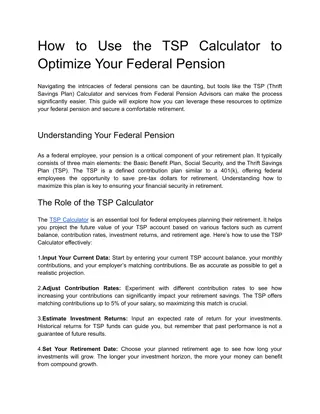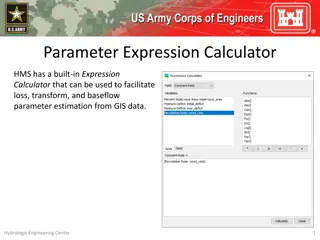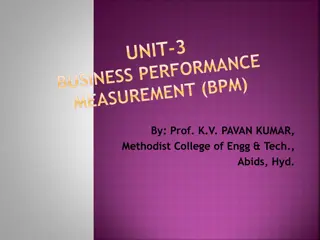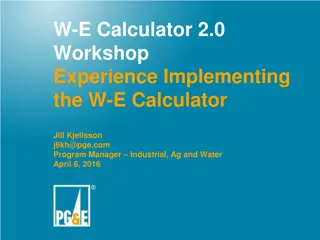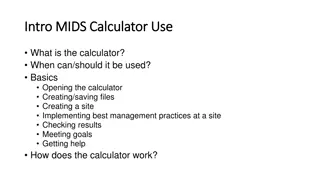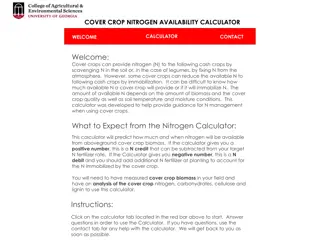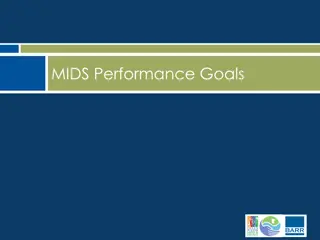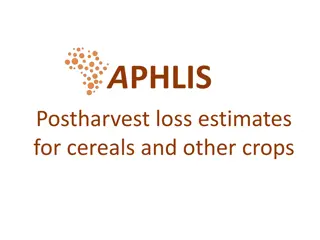Understanding MIDS Calculator Fundamentals and Performance Goals
The MIDS Calculator is a tool used to evaluate site conformance to MIDS performance goals, focusing on volume reduction and annual pollutant removal. It provides flexible treatment options tailored to site characteristics and goals. Learn about various simplifications of treatment options, jargon related to performance goals, and the importance of crediting methods. The calculator estimates runoff volume and pollutant load reductions, ensuring alignment with underlying assumptions of performance goal modeling.
Download Presentation

Please find below an Image/Link to download the presentation.
The content on the website is provided AS IS for your information and personal use only. It may not be sold, licensed, or shared on other websites without obtaining consent from the author. Download presentation by click this link. If you encounter any issues during the download, it is possible that the publisher has removed the file from their server.
E N D
Presentation Transcript
Presentation outline 1. Review MIDS performance goals 2. Volume reduction conformance calculations 3. Pollutant removal calculations 4. Pollutant load reduction calculations 5. Other calculator notes and functions
MIDS calculator Primary function of calculator is to evaluate site conformance to MIDS performance goals MIDS performance goals vary depending on site characteristics MIDS Flexible Treatment Options include - Volume retention requirements - % annual phosphorus removal requirements
A simplification of Flexible Treatment Options YES Primary Performance Goal: Retain 1.1 inch x Impervious Surface Area Good Infiltration NO Slow Infiltration Limited space, but some available Retain 0.55 inch x Impervious Surface Area AND YES 75% Annual TP Removal NO No Infiltration Restrictions (clay, contaminants, etc.) but space for BMP Volume retention to maximum extent possible AND 60% Annual TP Removal YES NO Offsite Mitigation
MIDS calculator Evaluates site conformance to MIDS performance goals, including - Volume reduction - % Annual Pollutant Removals (TP, DP, TSS) - No rate control Can be used to evaluate conformance to other goals (more/less stringent rules, TMDLs, etc.) Estimates annual runoff volume and pollutant load reductions
MIDS Calculator Calculator ensures crediting method(s) consistent with underlying assumptions of performance goal development modeling
Jargon Performance goal: Stormwater standard/rule Credit: Quantity of stormwater volume or pollutant reduction achieved by an individual BMP or cumulatively with multiple BMPs Volume retention/reduction = volume infiltrated or evaporated instead of leaving site as runoff TP: Total Phosphorus DP: Dissolved Phosphorus TSS: Total Suspended Sediment
Calculating volume reduction conformance For sites conducive to infiltration, MIDS volume reduction performance goal: Required Retention Volume 1.1 inch X = Volume reduction goal can vary depending on site constraints
Development of performance goal Continuous modeling analysis completed to establish 1.1-inch performance goal - Simulated 35-years using 15-minute precipitation data Modeling used to compare average annual runoff volumes from native conditions to runoff from developed conditions with infiltration BMPs of varying size
Development of performance goal Goal not time dependent (instantaneous versus continuous or event-based) Kerplunk method (Andy Reese terminology)
Calculates required volume retention Performance goal (1.1 inches * Impervious Area)
Calculates required volume retention For 10-acre site with 50% impervious, required volume retention = 19,965 ft3
Calculates Volume Retention Achieved Calculates volume reduction achieved to meet MIDS performance goal (based on entry of site BMP characteristics)
Calculating volume reduction conformance Volume reduction conformance calculated differently for infiltration and filtration Filtration: Infiltration: Permeable soil Impermeable soil Volume Captured in Basin Volume Infiltrated Volume Captured in Basin = Volume Infiltrated
Lets start with infiltration For most infiltration-based BMPs (w/o under drains), MIDS volume reduction achievement based on instantaneous retention volume Retention Volume Permeable soil
Calculating volume reduction For 10-acre site with 50% impervious, Required volume retention = 19,965 ft3 Retention Volume Required drawdown = 48 hours
Calculating volume reduction For 10-acre site with 50% impervious, Required volume retention = 19,965 ft3 Retention Volume
Lets move on to filtration Two common filtration scenarios: Under Drain at Bottom Elevated Under Drain Impermeable soil Impermeable soil
Filtration BMPs with under drain at bottom Significant volume discharged offsite through under drain Impermeable soil
But theres some volume loss, even with a under drain, right? Volume Losses will occur via: Infiltration (side slopes and bottom) Evapotranspiration Evapotranspiration Infiltration
Filtration BMPs with under drain at bottom For filtration BMPs with under drain at the bottom, MIDS volume reduction is calculated based on: - Infiltration from bottom and side slopes during required drawdown time (48 or 24 hours) - Evapotranspiration in 72 hours Underlying design assumption- under drain should be designed to empty filtration basin in 24 - 48 hours (volume credits will be overestimated if basin drains too fast)
Example: Filtration BMP with under drain at bottom Site: 10 acres, 50% Impervious C soils (infiltration 0.20 in/hr) Live storage = 1.5 feet Filtration media depth = 3.8 ft Area at overflow = 14,641 ft2 Media surface area = 11,881 ft2 Bottom surface area = 7,225 ft2 No tree; Mix C Field capacity = 0.11 Porosity = 0.25 Evapotranspiration = 297 ft3 Infiltration = 2499 ft3
Example: Filtration BMP with under drain at bottom Total volume retention credit with under drain at bottom = Evapotranspiration = 460 ft3 = 2,499 ft3 + 297 ft3 = 2,795 ft3 Compared with volume retention credit without under drain = 19,965 ft3 Infiltration = 2,624 ft3
Example: Filtration BMPs with elevated under drain With elevated under drain, credit is given for volume stored below under drain plus ET and side infiltration Evapotranspiration (ET) Impermeable soil
Filtration BMPs with elevated under drain Site: 10 acres, 50% Impervious C soils (infiltration 0.2 in/hr) Overflow depth = 1.5 feet Media depth = 3.8 ft Under drain 0.8 ft from bottom Area at overflow = 14,641 ft2 Media surface area = 11,881 ft2 Area at under drain = 7,225 ft2 Bottom surface area = 6,178 ft2 No tree; Mix C Field capacity = 0.11 Porosity = 0.25 Evapotranspiration = 297 ft3 Side Slope Infiltration = 890 ft3 Impermeable soil Volume stored below under drain = 1,340 ft3 Bottom Infiltration = 1,734 ft3
Filtration BMPs with elevated under drain Total volume retention credit with elevated under drain = 1734 ft3 + 890 ft3 + 1340 ft3 + 297 ft3 Evapotranspiration = 460 ft3 = 4,261 ft3 Compared with volume retention credits : w/under drain at bottom = 3,084 ft3 without under drain = 19,965 ft3 Side Slope Infiltration = 890 ft3 Impermeable soil Volume below under drain = 2,144 ft3
Questions on volume reduction conformance calculations?
Fundamentals of MIDS Calculator Pollutant Removal Calculations
A simplification of Flexible Treatment Options YES Primary Performance Goal: Retain 1.1 inch x Impervious Surface Area Good Infiltration NO Slow Infiltration Limited space, but some available Retain 0.55 inch x Impervious Surface Area AND YES 75% Annual TP Removal NO No Infiltration Restrictions (clay, contaminants, etc.) but space for BMP Volume retention to maximum extent possible AND 60% Annual TP Removal YES NO Offsite Mitigation
Calculating annual pollutant removal Calculator estimates % annual pollutant removal achieved - For each individual BMP - Cumulative % annual removal for site - Total Phosphorus (TP), Dissolved Phosphorus (DP), and Total Suspended Sediment (TSS)
Calculating annual pollutant removal Why? - To show conformance with MIDS Flexible Treatment Options (FTOs) or other local requirements - Reduction of TSS & P for TMDLs (Total Maximum Daily Loads) - Information for grant applications
Basis of % annual pollutant removal calculations For volume retained on site, assume 100% pollutant removal For Volume NOT retained by BMP, assume 0% - 100% pollutant removal - Depending on BMP - Depending on if BMP is designed as a flow- through or bypass system
Calculating % annual pollutant removal Total % Pollutant Removal %RVR (100- %RVR) %PR Where, %RVR = % Annual Runoff Volume Retained Onsite %PR = % Pollutant Removal
Annual pollutant load reduction 9 % Annual Volume 0% TSS, Particulate P (PP), and Dissolved P (DP) Reduction 91% Annual Volume Retained 100% TSS, PP, DP Reduction
Example calculating % annual pollutant removal from bioretention w/o under drain Total % TP Removal %RVR (100- %RVR) %PR 91% (100- 91) 0% 91%
Calculating % Pollutant Removal Many BMPs achieve primary pollutant removal through other mechanisms - Filtration - Settling - Adsorption Calculator applies % removal assumptions to portions of stormwater not infiltrated
Runoff and pollutant removal assumptions in calculator % Pollutant Removal (Non-Volume Reduced Runoff) TP & TSS Volume Reduction % Annual Runoff Volume Retained (%RVR) BMP Particulate P Removal 0% 0% 45% 0% 82% 0% 0% 73% 36% 0% 85% 91% 0% Dissolved P Removal 0% 0% 0% 0% 0% 0% 0% 0% 0% 0% 0% 0% 0% Total P Removal 0% 0% 25% 0% 45% 0% 0% 40% 20% 0% 47% 50% 0% TSS Removal Green roof Bioretention basin Bioretention basin w/ underdrain Infiltration basin Permeable pavement Tree Trench Swale Side Slope Dry swale Dry swale w/ underdrain Wet swale Sand filter Stormwater pond Wetland Other 45% 0% 100% 100% 100% 100% 100% 100% 100% 100% 0% 0% 0% 0% Outflow EMC = 2.25 0% 60% 0% 74% 0% 0% 68% 68% 68% 85% 84% 68% User defined Calculate from lookup table Calculate from lookup table Calculate from lookup table Calculate from lookup table Calculate from lookup table Calculate from lookup table Calculate from lookup table Calculate from lookup table 0% 0% 0% 0% User defined Calculated from performance curves User defined User defined User defined User defined lookup table from MIDS P8 modeling (Vol LU Tabs) Commonwealth of Virginia Runoff Reduction Method MN Stormwater Manual
Example calculating % annual pollutant removal from filtration basin w/under drain If a filtration basin infiltrates 20% annual runoff volume, Annual % TP Removal %RVR (100- %RVR) %PR 20 (100- 20) 0.25 40%
Calculating % annual volume retained So, for a BMP designed to capture 1.1 inches of runoff from impervious surfaces, how does this translate to annual volume removal? How does it vary by site imperviousness? How does it vary by soil type? How does it vary if your BMP is sized for less than 1.1 inches?
Making the connection: Performance goal to % annual pollutant removal % Annual Removal
Making the Connection: Performance Curves used to Estimate % Annual Volume Retained 100% 90% Annual Percent Volume Reduction 80% 70% = 1.1 inch 60% 50% 40% 30% = 0.55 inch 20% A soils B Soils C Soils 10% 0% 0 5,000 10,000 15,000 20,000 25,000 30,000 35,000 40,000 BMP Volume [feet3]
Calculating % annual volume retained Performance curves were developed to determine annual volume reduction (%RVR) for most volume-reduction BMPs in calculator - This approach allows flexibility for designers (not one size fits all) - Utilize modeling results to develop performance curves - Example BMPs: Bioretention, permeable pavement, infiltration trenches
Calculating Pollutant Load Reductions in MIDS Calculator
Pollutant loading basics = x P H2O year Pollutant Load [mass/time] Runoff Volume [volume/time] Pollutant Concentration [mass/volume]
Estimating pollutant load reductions in MIDS calculator 1. Estimate pollutant load from site using Simple Method - e.g., How much phosphorus is being generated from your developed site before BMPs? 2. Apply % Pollutant Removal to estimate annual pollutant load reduction - e.g., What phosphorus load reduction can be expected if your BMP removes 50% annual TP?
Calculating annual pollutant load: the Simple Method Equation developed by Tom Schueler in 1987 Estimates runoff volume and pollutant loads on an annual basis Requires easily obtainable data
Calculating annual pollutant load: the Simple Method Simplified runoff volume calculation based on the following inputs: - Drainage Area - Annual rainfall - % Impervious, turf, and forest to calculate runoff coefficient Pollutant concentration for TP and TSS based on literature values for stormwater









